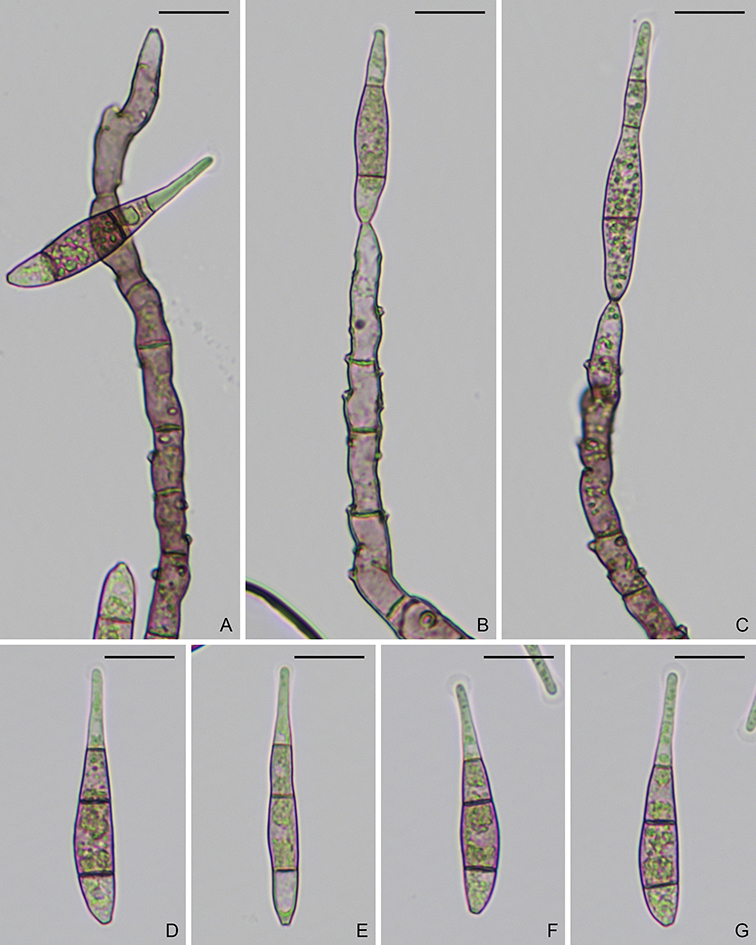Post Views:
1,019
Omnidemptus affinis P.F. Cannon & Alcorn, Mycotaxon 51: 483. 1994. (Type species).
Ascomata perithecial, solitary to gregarious, immersed, globose to subglobose, black, 145–205 μm diam, with a cylindrical, long neck, 100–250 μm long, 80–110 μm at base, 40–60 μm at apex. Paraphyses hyaline, septate, 3–6 μm wide. Asci 8-spored, unitunicate, cylindrical to clavate, 54–68 × 10–13 μm, with an apical ring, 2–3 × 4 μm. Ascospores biseriate, fusiform, curved, 1- or 3-septate, hyaline, smooth, 24.5–33 × 4–5.5 μm. In culture, hyphae septate, hyaline to light brown, smooth, 2–5.5 μm diam. Conidiomata irregularly shaped, dark brown to black, 50–160 μm diam. Conidiogenous cells ampulliform, cylindrical to ellipsoid, dark brown, 11–22 × 6–10 μm, with a cylindrical to flared collarette, 3–4 μm diam. Conidia falcate, 1–2-septate, hyaline, smooth, 21–30 × 3–4 μm. Hyphopodia lobed, olivaceous brown, smooth, 7.5–14 × 5–8.5(–11) μm (Description from Cannon and Alcorn, 1994).
Typification: Holotype BRIP17195. Isotype IMI353435. Ex-holotype culture BRIP17195 (CBS141031, ATCC 200212).
Gene sequences: JX134660 (18S), JX134674 (ITS), JX134686 (28S), JX134714 (MCM7), JX134728 (RPB1), JX134700 (TEF1).
Genome sequences: SRX798629 (transcriptome).
Hosts/substrates: From leaf spots of Panicum effusum (Poaceae).
Distribution: Australia, Spain.
Omnidemptus graminis Hern.-Restr., Gene & Guarro, Persoonia 42: 223. 2019.
Hyphae septate, hyaline to light brown, smooth, 1–3 μm diam. Conidiomata absent or sporodochium-like, irregularly shaped, diffuse, punctiform, dark brown to black. Conidiogenous cells ampulliform to subglobose, brown, smooth, 10–14 μm diam, with a cylindrical collarette, 1 × 3 μm. Conidia falcate, (0–)1-septate, hyaline, smooth, 11–23 × 3–4 μm. Hyphopodia lobed, brown, smooth, 10–15 × 7.5–10 μm, with 1–2 germ pores, 1–3 μm diam. Asexual state unknown.
Colonies on MEA 1.8–2 cm diam after 7 days at 25 °C; surface elevated, cottony, vinaceous buff; margin uneven; reverse black in center, white at periphery. Colonies on OA 3–4 cm diam after 7 days at 25 °C; surface zonate, center cottony, pale mouse grey, periphery glabrous, mouse grey; margin diffuse; reverse mouse grey (Description from Hernandez-Restrepo et al., 2019).
Typification: Holotype CBSH-21887. Ex-holotype culture CBS138107 (FMR12415).
Gene sequences: MK487758 (ITS), MK487734 (28S), MK495980 (TEF1).
Hosts/substrates: On leaves of grasses.
Distribution: Spain.
Omnidemptus lunatus (B. Sutton & Alcorn) Hern.-Restr., J.D.P. Bezerra & Crous, Persoonia 42: 223. 2019.
Conidiomata sporodochium, irregularly shaped, diffuse, light to medium brown. Conidiogenous cells ampulliform, doliiform to lageniform, light brown, smooth, 10.5 –13 × 6.5–11 μm, with a cylindrical collarette, 3–4.5 μm diam. Conidia falcate, 1-septate, hyaline, smooth, 24.5–32 × 3.5–4.5 μm (Description from Sutton and Alcorn, 1985).
Typification: Holotype IMI271703. Ex-holotype culture IMI271703 (BRIP13852).
Gene sequences: Unknown.
Hosts/substrates: On leaves of Carpobrotus glaucescens (Aizoaceae).
Distribution: Australia.
Copyright 2022 by The American Phytopathological Society. Reproduced, by permission, from Luo, J., and Zhang, N. 2022. The Rice Blast Fungus and Allied Species: A Monograph of the Fungal Order Magnaporthales (https://my.apsnet.org/APSStore/Product-Detail.aspx?WebsiteKey=2661527A-8D44-496C-A730-8CFEB6239BE7&iProductCode=46826). American Phytopathological Society, St. Paul, MN.
